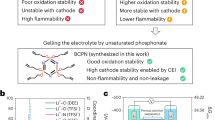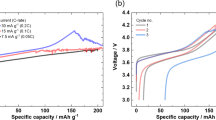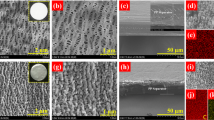Abstract
Polyethylene terephthalate (PET) tape is widely used by well-known lithium-ion battery manufacturers to prevent electrode stacks from unwinding during assembly. PET tape is selected since it has suitable mechanical and electrical properties, but its chemical stability has been largely overlooked. In the absence of effective electrolyte additives, PET can depolymerize into its monomer dimethyl terephthalate, which is an unwanted redox shuttle that induces substantial self-discharge in a lithium-ion cell. This study presents a chemical screening experiment to probe the PET decomposition mechanism involving in situ generated methanol and lithium methoxide from dimethyl carbonate, one of the most common electrolyte solvents in lithium-ion cells. By screening other polymers, it is found that polypropylene and polyimide (Kapton) are stable in the electrolyte. Finally, it is demonstrated that reversible self-discharge of LiFePO4–graphite cells can be virtually eliminated by replacing PET jellyroll tape with chemically stable polypropylene tape.
This is a preview of subscription content, access via your institution
Access options
Access Nature and 54 other Nature Portfolio journals
Get Nature+, our best-value online-access subscription
$29.99 / 30 days
cancel any time
Subscribe to this journal
Receive 12 print issues and online access
$259.00 per year
only $21.58 per issue
Buy this article
- Purchase on Springer Link
- Instant access to full article PDF
Prices may be subject to local taxes which are calculated during checkout






Similar content being viewed by others
Data availability
The datasets generated and analysed in the course of this study are included in the Supplementary Information. Source data are provided with this paper.
References
Revolutionizing Battery Safety. Soteria https://soteriabig.com/technology/ (2022).
DuPont Teijin Films. DuPont http://www.dupontteijinfilms.com/ (2023).
Functional Materials and Nanocomposites. Meta Materials Inc. https://metamaterial.com/ (2023).
Xie, K., Yu, S., Wang, P. & Chen, P. Polyethylene terephthalate-based materials for lithium-ion battery separator applications: a review based on knowledge domain analysis. Int. J. Polymer Sci. 2021, 6694105 (2021).
Logan, E. R. et al. Performance and degradation of LiFePO4/graphite cells: the impact of water contamination and an evaluation of common electrolyte additives. J. Electrochem. Soc. 167, 130543 (2020).
Büchele, S. et al. Reversible self-discharge of LFP/graphite and NMC811/graphite cells originating from redox shuttle generation. J. Electrochem. Soc. 170, 010518 (2023).
Buechele, S. et al. Identification of redox shuttle generated in LFP/graphite and NMC811/graphite cells. J. Electrochem. Soc. 170, 010511 (2023).
Tanaka, S., Sato, J. & Nakajima, Y. Capturing ethylene glycol with dimethyl carbonate towards depolymerisation of polyethylene terephthalate at ambient temperature. Green. Chem. 23, 9412–9416 (2021).
Sammon, C., Yarwood, J. & Everall, N. An FTIR study of the effect of hydrolytic degradation on the structure of thin PET films. Polym. Degrad. Stab. 67, 149–158 (2000).
Heider, U., Oesten, R. & Jungnitz, M. Challenge in manufacturing electrolyte solutions for lithium and lithium ion batteries quality control and minimizing contamination level. J. Power Sources 81–82, 119–122 (1999).
Strehle, B., Solchenbach, S., Metzger, M., Schwenke, K. U. & Gasteiger, H. A. The effect of CO2 on alkyl carbonate trans-esterification during formation of graphite electrodes in Li-ion batteries. J. Electrochem. Soc. 164, A2513 (2017).
Petibon, R. et al. Study of electrolyte components in Li ion cells using liquid-liquid extraction and gas chromatography coupled with mass spectrometry. J. Electrochem. Soc. 161, A1167–A1172 (2014).
Thompson, L. M. Study of electrolyte and electrode composition changes vs time in aged Li-ion cells. J. Electrochem. Soc. 168, 020532 (2021).
Adhesive Tape 101. The purpose and composition of tape. Can-Do National Tape https://www.can-dotape.com/adhesive-tape-consultant/tape-101/ (2023).
Polymer prices. Plastics Information Europe https://pieweb.plasteurope.com/default.aspx?pageid=200 (2023).
Wilkes, B. N., Brown, Z. L., Krause, L. J., Triemert, M. & Obrovac, M. N. The electrochemical behavior of polyimide binders in Li and Na cells. J. Electrochem. Soc. 163, A364–A372 (2016).
Sinha, N. N. et al. The use of elevated temperature storage experiments to learn about parasitic reactions in wound LiCoO2/graphite cells. J. Electrochem. Soc. 158, A1194 (2011).
Logan, E. R. et al. The use of LiFSI and LiTFSI in LiFePO4/graphite pouch cells to improve high-temperature lifetime. J. Electrochem. Soc. 169, 040560 (2022).
Boetticher, T., Adamson, A., Buechele, S., Alter, E. D. & Metzger, M. Understanding the self-discharge redox shuttle mechanism of dimethyl terephthalate in lithium-ion batteries. J. Electrochem. Soc. 170, 060507 (2023).
Haruna, H., Takahashi, S. & Tanaka, Y. Accurate consumption analysis of vinylene carbonate as an electrolyte additive in an 18650 lithium-ion battery at the first charge-discharge cycle. J. Electrochem. Soc. 164, A6278–A6280 (2017).
Burns, J. C. et al. Studies of the effect of varying vinylene carbonate (VC) content in lithium ion cells on cycling performance and cell impedance. J. Electrochem. Soc. 160, A1668 (2013).
Bond, T. M., Burns, J. C., Stevens, D. A., Dahn, H. M. & Dahn, J. R. Improving precision and accuracy in coulombic efficiency measurements of Li-ion batteries. J. Electrochem. Soc. 160, A521 (2013).
Acknowledgements
This work was funded under the auspices of the NSERC/Tesla Canada Alliance Grant programme. A.A., K.T., M.D.L.G. and S.A. thank the Tamkivi Natural Sciences Foundation, the European Regional Development Fund via the Dora Plus scholarship programme, project no. TK141 (grant no. 2014-2020.4.01.15-0011), and the Estonian Research Council (grant no. PRG676), Killam Foundation, NSERC Postgraduate Scholarship programme and the Nova Scotia Graduate Scholarship programme for scholarship support. We acknowledge J. Dahn for obtaining the 402035-sized pouch cells with PP tape.
Author information
Authors and Affiliations
Contributions
A.A. designed and carried out experiments, analysed the data, conceived the PET depolymerization mechanism in cells and wrote the paper. K.T. assisted with all UHPC and storage measurements and data analysis. T.B. codesigned and carried out the pouch bag experiments. S.A. performed long cycling on cells with PET tape and developed the method for electrolyte extraction used in the study. M.D.L.G. performed long cycling on cells with PET tape. M.M. provided supervision and guidance and edited the paper.
Corresponding author
Ethics declarations
Competing interests
The authors declare no competing interests.
Peer review
Peer review information
Nature Materials thanks the anonymous reviewers for their contribution to the peer review of this work.
Additional information
Publisher’s note Springer Nature remains neutral with regard to jurisdictional claims in published maps and institutional affiliations.
Supplementary information
Supplementary Information
Supplementary Figs. 1 and 2 and Schemes 1–5.
Source data
Source Data Figs. 1–6
Statistical source data.
Rights and permissions
Springer Nature or its licensor (e.g. a society or other partner) holds exclusive rights to this article under a publishing agreement with the author(s) or other rightsholder(s); author self-archiving of the accepted manuscript version of this article is solely governed by the terms of such publishing agreement and applicable law.
About this article
Cite this article
Adamson, A., Tuul, K., Bötticher, T. et al. Improving lithium-ion cells by replacing polyethylene terephthalate jellyroll tape. Nat. Mater. 22, 1380–1386 (2023). https://doi.org/10.1038/s41563-023-01673-3
Received:
Accepted:
Published:
Issue Date:
DOI: https://doi.org/10.1038/s41563-023-01673-3



